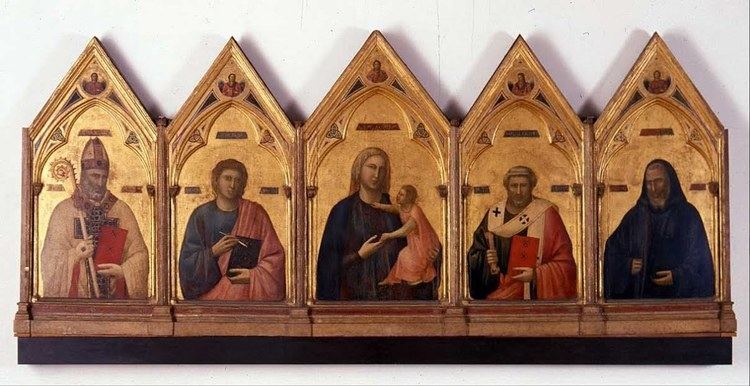Year c. 1300 Genre Christian art | Medium Tempera on panel Created 1301–1302 Media Paint, Tempera | |
 | ||
Dimensions 142 cm × 337 cm (56 in × 133 in) Similar Giotto artwork, Artwork at Uffizi Gallery, Tempera | ||
The Badia Polyptych (Italian: Polittico di Badia) is a painting by the Italian artist Giotto, painted around 1300 and housed in the Uffizi Gallery of Florence.
Contents
History
Contemporary sources such as Lorenzo Ghiberti's Commentarii and Giorgio Vasari's Lives agree in mentioning the presence of a polyptych by Giotto at the high altar in the Badia Fiorentina. However, the work is no more document for centuries, and was considered to be lost. In the 19th century, however, it was found in the archives of the Museum of Santa Croce of Florence, and identified thanks to a cartouche on it saying "Badia di Firenze", which was added in 1810. The dating of the work is disputed, ranging from the early 14th century to a period following Giotto's work in the Cappella degli Scrovegni.
The polyptych was restored in the 1958 and again, after escaping the 1966 Flood of the River Arno, in 2000.
Description
The work is composed by five framed paintings with a triangular cusp, and portrays the busts of the Virgin (center) and, from the left, Sts. Nicholas of Bari, John the Evangelist, Pieter and Benedict, identified by their names below and their traditional attributes.
Giotto made an extensive use of chiaroscuro. Details include the rich garments and the crosier of St. Nicholas, the gesture of the Child grasping at his mother's neckline and St. Peter's stole. Similar details were used by Giotto also in Rimini Crucifix and the Stigmata of St. Francis, and have led to the 14th century dating.
